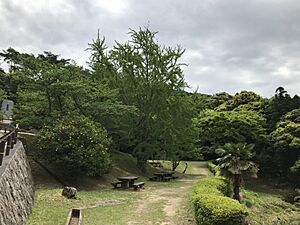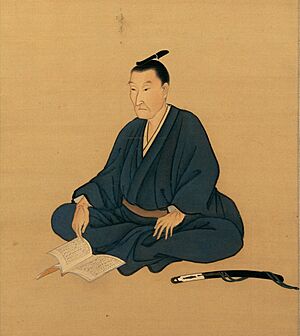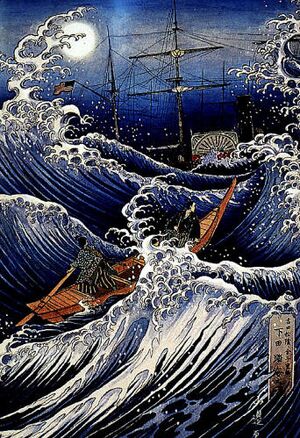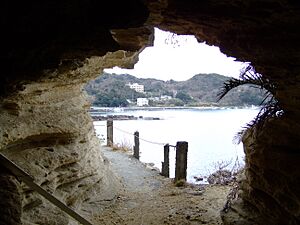Yoshida Shōin facts for kids
Quick facts for kids
Senior Fourth Rank
Yoshida Shōin
|
|
|---|---|
| 吉田 松陰 | |
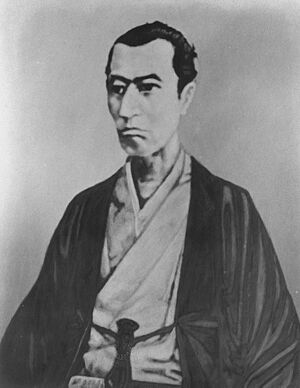 |
|
| Born |
Sugi Toranosuke (杉 寅之助)
September 20, 1830 Hagi, Nagato Province, Japan
|
| Died | November 21, 1859 (aged 29) Edo, Japan
|
| Cause of death | execution |
| Nationality | Japanese |
| Other names | Torajirō (寅次郎) |
| Occupation | scholar |
| Era | Edo period |
| Parent(s) | Sugi Yurinosuke (father) Kodama Taki (mother) |
| Relatives | Sugi Umetarō (brother) Kodama Yoshiko (sister) Odamura Hisa (sister) Sugi Tsuya (sister) Miwako Katori (sister) Sugi Toshisaburō (brother) Tamaki Bunnoshin (uncle) Yoshida Daisuke (adoptive father) |
| Scientific career | |
| Institutions | Meirinkan Shōka Sonjuku |
| Academic advisors | Yusuke Yamada Sakuma Shōzan Asaka Gonsai Miyabe Teizō Yamaga Sosui |
| Notable students | Takasugi Shinsaku Kido Takayoshi Akane Taketo Itō Hirobumi Kusaka Genzui Inoue Kaoru Yamagata Aritomo |
Yoshida Shōin (吉田松陰, born Sugi Toranosuke (杉 寅之助); September 20, 1830 – November 21, 1859) was a very important Japanese thinker. He lived during the last years of the Tokugawa shogunate, a time when Japan was ruled by military leaders called shōgun. Yoshida Shōin helped train many young leaders. These leaders later played a big part in the Meiji Restoration. This was a major change that brought the emperor back to power in Japan.
Contents
Early Life and Education
Yoshida Shōin was born Sugi Toranosuke in Hagi, Japan. His father, Sugi Yurinosuke, was a samurai. When he was four years old, Yoshida Toranosuke was adopted by his uncle, Yoshida Daisuke. This was a common practice to keep family lines strong. He then became known as Yoshida Shōin.
His family had a special role: they taught military studies to the local ruler, called the daimyō. Because Shōin was so young, his uncle Tamaki helped speed up his education. By age nine, he was learning military arts at a school called Meirinkan.
Shōin was very smart. When he was 11, he gave an excellent lecture to the daimyō Mōri Takachika. At 13, he even led a military exercise. This exercise showed how to defend against Western ships.
He continued his studies in different places. In 1851, he went to Edo (now Tokyo). There, he learned about Western military science from teachers like Sakuma Shōzan. This intense learning helped him become the important educator he was.
A Trip and Its Consequences
In 1851, Yoshida Shōin took a four-month trip across Japan. He had permission from his local government, but he left before getting it in writing. This was a serious offense called "fleeing the han." When he returned in 1852, he was punished.
He lost his samurai status and his income. However, his punishment also gave him a special chance. He was allowed to study anywhere in Japan for ten years. This freedom let him learn even more.
In 1853, he went back to Edo to continue his studies. This was just when Matthew Perry and his "Black Ships" arrived in Japan. Perry's arrival changed Japan forever.
Trying to See the World
In 1853 and 1854, Matthew Perry visited Japan with his ships. Yoshida Shōin and his teacher, Sakuma Shōzan, wanted to learn more about the West. They asked the Japanese government if they could travel to the United States. Their request was denied.
But Shōin was determined. He decided to try and sneak onto one of Perry's ships. He went to Shimoda, where Perry's ships were docked. First, he tried to give a letter asking to be let on board.
Then, one night, he tried to secretly climb onto the ship USS Powhatan. Perry's crew saw them, and they were turned away. Soon after, Japanese guards caught them. Shōin was sent to jail in Edo, then to his hometown of Hagi. He was placed under house arrest.
Teaching and Rebellion
Even while in jail, Yoshida Shōin started a small school. After he was released, he took over his uncle's private school, Shōka Sonjuku. He taught young people military arts and politics. Since he couldn't travel, he sent his students across Japan to gather information.
By 1858, Japan's government, the bakufu, was signing treaties with Western countries. Some people, like Shōin, believed this was wrong. They wanted to protect the emperor and remove foreigners. These people were called sonnō jōi rebels.
Yoshida Shōin decided to take action. He tried to gather support to stop a powerful government official, Ii Naosuke. His plan did not get much support. Still, he and a few students tried to attack Ii's servant in Kyoto. The plan failed, and Shōin was put in prison again.
His Final Days
In 1859, Yoshida Shōin was sent to a prison in Edo. He admitted his part in the plan to stop the official. Even from prison, he kept planning for change. He was executed on November 21, 1859, at the age of 29.
Before his death, he wrote a final poem. He was first buried near the execution site. Later, in 1863, his supporters reburied him in Wakabayashi, Edo.
Lasting Impact
Yoshida Shōin's ideas and teachings lived on through his students. At least five of them became very famous. These included Takasugi Shinsaku, Katsura Kogorō, Inoue Kaoru, Itō Hirobumi, and Yamagata Aritomo. Many of his students became important leaders in the Meiji Restoration.
Takasugi Shinsaku led forces against the shōgun and helped bring down the Tokugawa government. Itō Hirobumi later became Japan's first prime minister. This shows how much Yoshida Shōin influenced the future of Japan.
Legacy and Recognition
In 1882, Yoshida Shōin was honored at the Shōin shrine in Tokyo. A main building for the shrine was built in 1927. There is also a shrine dedicated to him in his birthplace, Hagi.
In 1888, he was honored at the Yasukuni Shrine. He was also given a high rank by the government in 1889.
Shoin University was named after him. There are other universities with "Shoin" in their names, but they are not connected to him.
A Japanese TV show called Hana Moyu was made in 2015. It told the story of Yoshida Shōin's younger sister, Sugi Fumi. The show helped people learn more about Yoshida Shōin and his time.
See also
 In Spanish: Yoshida Shōin para niños
In Spanish: Yoshida Shōin para niños


